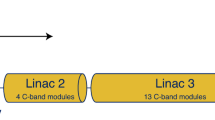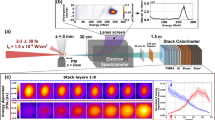Abstract
Bright sources of high-energy electromagnetic radiation are widely employed in fundamental research, industry and medicine1,2. This motivated the construction of Compton-based facilities planned to yield bright gamma-ray pulses with energies up to3 20 MeV. Here, we demonstrate a novel mechanism based on the strongly amplified synchrotron emission that occurs when a sufficiently dense ultra-relativistic electron beam interacts with a millimetre-thickness conductor. For electron beam densities exceeding approximately 3 × 1019 cm−3, electromagnetic instabilities occur, and the ultra-relativistic electrons travel through self-generated electromagnetic fields as large as 107–108 gauss. This results in the production of a collimated gamma-ray pulse with peak brilliance above 1025 photons s−1 mrad−2 mm−2 per 0.1% bandwidth, photon energies ranging from 200 keV to gigaelectronvolts and up to 60% electron-to-photon energy conversion efficiency. These findings pave the way to compact, high-repetition-rate (kilohertz) sources of short (≲30 fs), collimated (milliradian) and high-flux (>1012 photons s−1) gamma-ray pulses.
This is a preview of subscription content, access via your institution
Access options
Access Nature and 54 other Nature Portfolio journals
Get Nature+, our best-value online-access subscription
$29.99 / 30 days
cancel any time
Subscribe to this journal
Receive 12 print issues and online access
$209.00 per year
only $17.42 per issue
Buy this article
- Purchase on Springer Link
- Instant access to full article PDF
Prices may be subject to local taxes which are calculated during checkout





Similar content being viewed by others
References
Bilderback, D. H., Elleaume, P. & Weckert, E. Review of third and next generation synchrotron light sources. J. Phys. B. 38, S773–S797 (2005).
Ullrich, J., Rudenko, A. & Moshammer, R. Free-electron lasers: new avenues in molecular physics and photochemistry. Annu. Rev. Phys. Chem. 63, 635–660 (2012).
Extreme Light Infrastructure - Nuclear Physics; http://www.eli-np.ro/
Di Piazza, A., Müller, C., Hatsagortsyan, K. Z. & Keitel, C. H. Extremely high-intensity laser interactions with fundamental quantum systems. Rev. Mod. Phys. 84, 1177–1228 (2012).
Sarri, G. et al. Ultrahigh brilliance multi-MeV γ-ray beams from nonlinear relativistic Thomson scattering. Phys. Rev. Lett. 113, 224801 (2014).
Phuoc, K. T. et al. All-optical Compton gamma-ray source. Nat. Photon. 6, 308–311 (2012).
Jirka, M. et al. Electron dynamics and γ and e − e + production by colliding laser pulses. Phys. Rev. E. 93, 023207 (2016).
Gonoskov, A. et al. Ultrabright GeV photon source via controlled electromagnetic cascades in laser-dipole waves. Phys. Rev. X. 7, 041003 (2017).
Ridgers, C. P. et al. Dense electron–positron plasmas and ultraintense γ rays from laser-irradiated solids. Phys. Rev. Lett. 108, 165006 (2012).
Nakamura, T. et al. High-power γ-ray flash generation in ultraintense laser–plasma interactions. Phys. Rev. Lett. 108, 195001 (2012).
Stark, D. J., Toncian, T. & Arefiev, A. V. Enhanced multi-MeV photon emission by a laser-driven electron beam in a self-generated magnetic field. Phys. Rev. Lett. 116, 185003 (2016).
Giulietti, A. et al. Intense γ-ray source in the giant-dipole-resonance range driven by 10-TW laser pulses. Phys. Rev. Lett. 101, 105002 (2008).
Fill, E. E. Relativistic electron beams in conducting solids and dense plasmas: Approximate analytical theory. Phys. Plasmas 8, 1441–1444 (2001).
Kittel, C. Introduction to Solid State Physics 8th edn (John Wiley and Sons, Hoboken NJ, 2005).
Weibel, E. S. Spontaneously growing transverse waves in a plasma due to an anisotropic velocity distribution. Phys. Rev. Lett. 2, 83–84 (1959).
Bret, A., Firpo, M.-C. & Deutsch, C. Characterization of the initial filamentation of a relativistic electron beam passing through a plasma. Phys. Rev. Lett. 94, 115002 (2005).
Califano, F., Del Sarto, D. & Pegoraro, F. Three-dimensional magnetic structures generated by the development of the filamentation (Weibel) instability in the relativistic regime. Phys. Rev. Lett. 96, 105008 (2006).
Lee, R. & Lampe, M. Electromagnetic instabilities, filamentation, and focusing of relativistic electron beams. Phys. Rev. Lett. 31, 1390–1393 (1973).
Askar’yan, G. A., Bulanov, S. V., Pegoraro, F. & Pukhov, A. M. Nonlinear evolution of ultrastrong laser pulses in a plasma – New phenomena of magnetic interaction between strong electromagnetic beams. Plasma Phys. Rep. 21, 835–846 (1995).
Califano, F., Pegoraro, F. & Bulanov, S. V. Spatial structure and time evolution of the Weibel instability in collisionless inhomogeneous plasmas. Phys. Rev. E. 56, 963–969 (1997).
Lau, Y. Y. & Chu, K. R. Electron-cyclotron maser instability driven by a loss-cone distribution. Phys. Rev. Lett. 50, 243–246 (1983).
D’Angelo, M., Fedeli, L., Sgattoni, A., Pegoraro, F. & Macchi, A. Particle acceleration and radiation friction effects in the filamentation instability of pair plasmas. Mon. Not. R. Astron. Soc. 451, 3460–3467 (2015).
Hossain, M., Matthaeus, W. H. & Montgomery, D. Long-time states of inverse cascades in the presence of a maximum length scale. J. Plasma Phys. 30, 479–493 (1983).
Leemans, W. P. et al. Multi-GeV electron beams from capillary-discharge-guided subpetawatt laser pulses in the self-trapping regime. Phys. Rev. Lett. 113, 245002 (2014).
Wang, W. T. et al. High-brightness high-energy electron beams from a laser wakefield accelerator via energy chirp control. Phys. Rev. Lett. 117, 124801 (2016).
Malka, V. et al. Principles and applications of compact laser-plasma accelerators. Nat. Phys. 4, 447–453 (2008).
Bret, A., Firpo, M.-C. & Deutsch, C. Electromagnetic instabilities for relativistic beam-plasma interaction in whole k space: nonrelativistic beam and plasma temperature effects. Phys. Rev. E 72, 016403 (2005).
Bret, A. & Deutsch, C. Stabilization of the filamentation instability and the anisotropy of the background plasma. Phys. Plasmas. 13, 022110 (2006).
Baier, V. N., Katkov, V. M. & Strakhovenko, V. M. Electromagnetic Processes at High Energies in Oriented Single Crystals (World Scientific, Singapore, 1998).
Tsai, Y.-S. Pair production and bremsstrahlung of charged leptons. Rev. Mod. Phys. 46, 815–851 (1974).
Arber, T. D. et al. Contemporary particle-in-cell approach to laser-plasma modelling. Plasma Phys. Control. Fusion 57, 113001 (2015).
Miller, R. B. An Introduction to the Physics of Intense Charged Particle Beams (Plenum Press, New York, 1982).
Patrignani, C. et al. Review of particle physics. Chin. Phys. C 40, 100001 (2016).
NIST Atomic Spectra Database version 5 (NIST, 2017); http://physics.nist.gov/asd.
Molière, G. Theory of the scattering of fast charged particles. 2. Repeated and multiple scattering. Z. Nat. A 3, 78–97 (1948).
Bethe, H. A. Molière’s theory of multiple scattering. Phys. Rev. 89, 1256–1266 (1953).
Rossi, B. & Greisen, K. Cosmic-ray theory. Rev. Mod. Phys. 13, 240–309 (1941).
Koch, H. W. & Motz, J. W. Bremsstrahlung cross-section formulas and related data. Rev. Mod. Phys. 31, 920–955 (1959).
Seltzer, S. M. & Berger, M. J. Bremsstrahlung energy spectra from electrons with kinetic energy 1 keV–10 GeV incident on screened nuclei and orbital electrons of neutral atoms with Z = 1–100. At. Data Nucl. Data Tables 35, 345–418 (1986).
Landau, L. D. & Pomeranchuk, I. Ya. The limits of applicability of the theory of Bremsstrahlung by electrons and of the creation of pairs at large energies. Dokl. Akad. Nauk. SSSR 92, 535–536 (1953).
Landau, L. D. & Pomeranchuk, I.Ya. Electron-cascade processes at ultra-high energies. Dokl. Akad. Nauk. SSSR 92, 735–738 (1953).
Migdal, A. B. Bremsstrahlung and pair production in condensed media at high energies. Phys. Rev. 103, 1811–1820 (1956).
Ritus, V. I. Quantum effects of the interaction of elementary particles with an intense electromagnetic field. J. Sov. Laser Res. 6, 497–617 (1985).
Jackson, J. D. Classical Electrodynamics 3rd edn (John Wiley and Sons, New York, 1998).
XCOM: Photon Cross Sections Database (NIST, 2010); https://www.nist.gov/pml/xcom-photon-cross-sections-database.
Acknowledgements
The authors would like to thank N. Kumar for valuable discussions and suggestions.
Author information
Authors and Affiliations
Contributions
A.B. initially conceived the research project with input from M.T., configured and carried out the simulations, generated the figures and wrote the bulk of the manuscript. M.T. implemented the routines accounting for multiple scattering, bremsstrahlung and synchrotron radiation into the particle-in-cell code EPOCH. A.B. and M.T. discussed the physics, and analysed and interpreted the results of the simulations. C.H.K. supervised the project. All authors contributed to the preparation of the manuscript.
Corresponding author
Ethics declarations
Competing interests
The authors declare no competing interests.
Additional information
Publisher’s note: Springer Nature remains neutral with regard to jurisdictional claims in published maps and institutional affiliations.
Supplementary information
Supplementary Information
Supplementary notes and figures
Rights and permissions
About this article
Cite this article
Benedetti, A., Tamburini, M. & Keitel, C.H. Giant collimated gamma-ray flashes. Nature Photon 12, 319–323 (2018). https://doi.org/10.1038/s41566-018-0139-y
Received:
Accepted:
Published:
Issue Date:
DOI: https://doi.org/10.1038/s41566-018-0139-y
This article is cited by
-
Brilliant femtosecond-laser-driven hard X-ray flashes from carbon nanotube plasma
Nature Photonics (2023)
-
Self-organization of photoionized plasmas via kinetic instabilities
Reviews of Modern Plasma Physics (2023)
-
Forward-looking insights in laser-generated ultra-intense γ-ray and neutron sources for nuclear application and science
Nature Communications (2022)
-
Brilliant gamma-ray beam and electron–positron pair production by enhanced attosecond pulses
Communications Physics (2018)
-
Instability yields bright gamma emission
Nature Photonics (2018)



